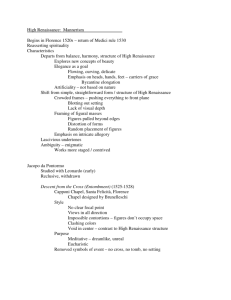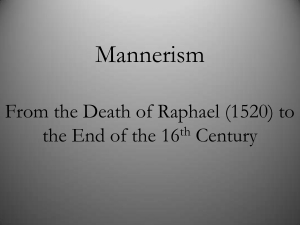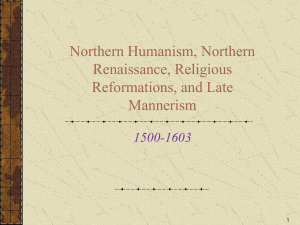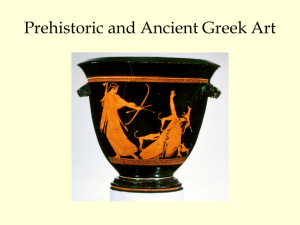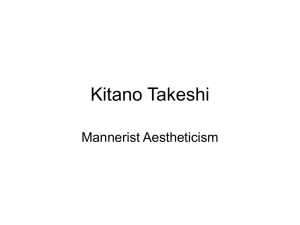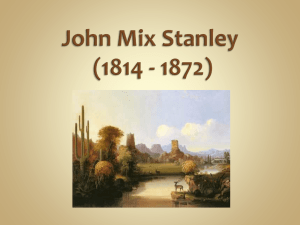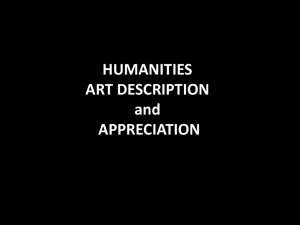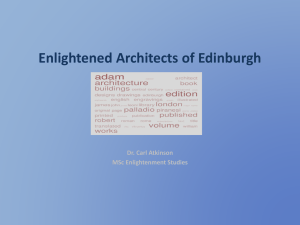Mannerism and Other Trends of Late Sixteenth Century Italy
advertisement
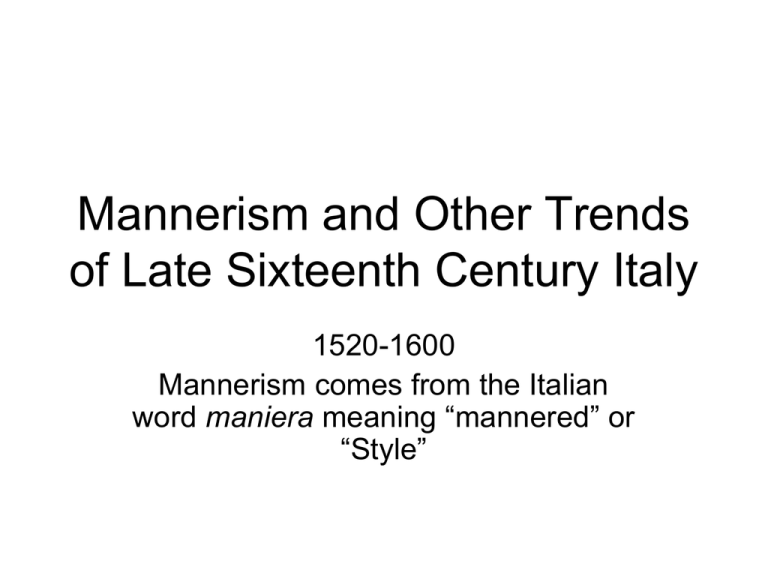
Mannerism and Other Trends of Late Sixteenth Century Italy 1520-1600 Mannerism comes from the Italian word maniera meaning “mannered” or “Style” Key Ideas • Mannerist art is deliberately intellectual, asking the viewer to respond in a sophisticated way to the spatial challenges presented in a painting or sculpture • Mannerist painting and sculpture are characterized by complicated compositions, distorted figure styles, and complex allegorical interpretations Key Ideas • Mannerist architecture often employs classical elements in a new and unusual way that defies traditional formulas. Historical background • Even though the Protestant Reformation was treated as a heresy in Italy, it had a dramatic impact on Italian art. • Mannerist distortions were more appropriate in in this contentious period. • Basic tenets of Mannerism concern the tension between the ideal, the natural, and the symmetrical against the real, the artificial, and the unbalanced. Historical background • Catholic response to the Reformation was the Council of Trent (1545-1563) later termed the Counter Reformation. • Jesuits were created for teaching and missionary work, who became great patrons of the arts when they saw the power of art as a teaching tool. Patronage and Artistic Life • First painting academy established by Cosimo I of Florence 1563 to train artists and improve their status in society. • Artists did not necessarily work for only one patron. They tried to keep several happy at a time. • Benvenuto Cellini, a Mannerist sculptor, wrote an extensive Autobiography 1558-1562 detailing his relationship with kings and princes. Patronage and Artistic Life • Giorgio Vasari wrote a definitive series of biographies on the greatest painters from Cimabue to Michelangelo in 1550, then updated it in 1558. • Andrea Palladio wrote a book that became one of the most influential books ever written on architecture. His Four Books on Architecture became a standard for the professional and amateur, an influence that has been felt even into the twentieth century. Innovations and Characteristics of Mannerist Architecture • Mannerist architects engage the viewer in the use of classical elements independent of their original function • Palazzo del T’e, a bold interlocking of classical forms that were arranged in a way to make us ponder the significance of ancient architecture in the Renaissance. Giulio Romano, Palazzo del T’e, 1525-1535, Matnua, Italy Exterior Interior courtyard •Horse farm and a villa •Unsettling architectural setting •Triglyphs dip into the cornice, creating holes above •Pediment corners do not meet •Window openings at unconventional locations Engaged columns divide façade into unequal bays Massive columns carry almost no weight, a narrow cornice Keystone pops out of the arches Oddly sized stones Highly unusual placement of arch, below a pediment Giacomo della Porta, Il Gesu’ façade, 15751584, Rome •Head church of the Jesuit order •Column groupings emphasize central doorway •Tympana and pediment over central door •Slight crescendo of forms toward the center Two stories separated by cornice; united by scrolls Framing niche acts as a unifying device Interior has no aisles, meant for grand ceremonies Innovations of Mannerist Painting • Typical High Renaissance painting had a perspective that led the eye to a central point. Mannerists chose to discard conventional theories of perspective by having the eye wander around a picture plane or use the perspective to create an interesting illusion • Mannerists used High Renaissance forms as a starting point to freely change the ideals of the previous generation. Innovations of Mannerist Painting • Mannerists defied the conventional classical order and rationality of High Renaissance that gave it the style much of its appeal. • New artistic subject; Still life, understood as lowest form of painting, it was accepted by seventeenth century Holland • Genre: was introduced as scenes of everyday life, became acceptable. Jacopo da Pontormo, Entombment, 1525-1528, oil on wood, Santa Felicita’ , Florence •Hole in the center of the circular composition •Elongation of bodies •High-keyed colors, perhaps taking into account the darkness of the chapel •No ground line for many figures; what is Mary sitting on? •Hands seem disembodied •Some androgynous figures •No weeping, just yearning •Linear bodies twisting around one another Antonio Correggio, Assumption of the Virgin, 1526-1530, fresco, Parma Cathedral •View of the sky with hundreds of figures flying overhead in concentric rings •Weightlessness of the bodies •Clouds appear as soft and elusive masses Saints at lowest level; second level has the Virgin escorted to heaven with angels; celestial glory at top with Christ waiting to receive his mother Glowing colors set in a blazing setting that prefigures the Baroque Parmigianino, Madonna of the Long Neck, 1535, oil on wood, Uffizi, Florence •Small head, long neck, delicate gesture, graceful hand •Crowding of heads on left •Elongated and unattached limbs •Column appears to be singular at top but descends to a row of columns at bottom •Small figure at the base strangely out of proportion; role in the painting the painting uncertain •Pose of Mary and Jesus reminiscent of the Pieta’ Agnolo Bronzino, Venus, Cupid, Folly, and Time, 1546, National Gallery, London •Commissioned by Cosimo de’ Medici of Florence as a gift to Francis I of France •Complicated allegorical structure that invites a multiplicity of meanings •Cupid kisses his mother Venus, but has his eye on her golden apple; he rests on a pillow, indicating his idleness •Venus responds to Cupid, but removes an arrow behind his back from his quiver •Folly throws flowers at the couple •Masks are falseness; doves are love •Fraud or Vanity has a beautiful face and offers a honeycomb, but underneath she is an animal and has a poisonous lizard in her other hand; her hands seem to be reversed •Envy on the left is green; has recently been symbolically interpreted as syphilis •Fury or Truth at top left; time at top right, exposing all •Has been interpreted as a morality piece about syphilis •Complex imagery and poses •Figures in a congested composition pushed to the forefront of the picture plane Jacopo Tintoretto, The Last Supper, 1594, oil on canvas, Santa Maria Maggiore, Rome •Christ in the center, yet powerful diagonals pull the eye into the distance •Elongated figures •Light reveals flying upside down angels •Light casts long shadows •Many details of everyday life dominate painting •No action, no announcement of betrayal, nameless apostles, insignificant Judas •Christ gives the Eucharist to Saint Peter •Point of view was originally from an angle which would have given it more balance. Innovations of Mannerist Sculpture • Freed the viewer from looking only at the frontal position such as Michelangelo and Donatello used. • Mannerists, like Bologna, make us move around the work to appreciate it. • The Mannerist painters used elongation of figures that transferred to sculpture as well. Innovations of Mannerist Sculpture • Intertwining figures have their legs and arms inexplicably intermeshed • Disembodied hands appear, sometimes floating space in a mix of bodies • Negative space, the anathema of High Renaissance sculpture, is the hallmark of Mannerism • Compositions are often crowded, inviting the viewer to examine the details to understand the whole. Giovanni da Bologna, Abduction of the Sabine Women, 1583, marble, Florence •Title of the work given later •Sculpted as a set piece •Spiral movement • Must be seen in the round •Negative space •References to Laocoon •It had been thought that the ancients sculpted monumental works from one block of stone; Renaissance artists discovered this was untrue; Bologna wanted to surpass the ancients by carving from one block •Symbolism of the Medici (young man) taking Florence (the woman) from the preceding government (the old man) Classicizing Trend in Late-Fifteenth Century Art and Architecture • High Renaissance painting never faded in the sixteenth century, despite Mannerist art. • Veronese continued to work on grand compositions with majestic architectural elements of size. • Courtly gestures and theatrical elements dominate paintings. Classicizing Trend in Late-Fifteenth Century Art and Architecture • Mannerist architects, like Romano, delighted the senses by breaking the academic code. • Palladio revitalized classical forms (Villa Rotunda) • Palladio’s San Giorgio Maggiore, is more Mannerist in its intersection of Pediments and columns Paolo Veronese, Christ in the House of Levi, 1573, oil on canvas, Academy, Venice Originally titled Last Supper but name was changed because it was deemed inappropriate for a sacred scene Mary and Christ lost in a vast array of miscellaneous figures Sumptuous setting; architecture overwhelms, courtly gestures, brocaded costumes Andrea Palladio, Villa Rotunda, 1566-1570, Vincenza, Italy •Building has four identical facades, each with a different view •Interior has rotunda, with four larger rooms alternating with four smaller spaces to allow for more intimate settings •When building viewed from afar, no matter from what angle, it looks complete •Used as a working farm, family estate, villa retreat •Villa appears as a mini temple; perhaps a residence of the Muses; ideal nature of the central plan evokes the ancients •Symmetrical ground plan •Low round Roman-style dome, not the domes of the Renaissance •Originally the dome had an oculus, like the Pantheon, now glazed •Building set on a high podium; pediments dominate doors and windows Andrea Palladio, San Giorgio Maggiore, 1565, Venice •Interlocking pediments and columns •High pedestals for columns •More Mannerist than the Villa Rotunda, two temple facades intersect •Clearly lit interior Test • 1. The artist of this work is A. Tintoretto B. Porta C. Veronese D Bologna • A. B. C. D. 2. This work was carved from one piece of marble because The artist wanted to challenge the ancients There was only one piece of marble left in the quarry Marble was the approved medium of the ancients The cost of marble had gone up • A. B. C. D. 3. Which ancient work of sculpture inspired this composition? Venus de Milo Laocoon Discus Thrower Nike of Samothrace • A. B. C. D. 4. Mannerist paintings can be characterized by Harmony Symmetry Rich colors artifice 5. A new type of painting introduced in the Mannerist period is the A. Landscape B. Mythological painting C. Still life D. abstract 6. Correggio’s ceiling painting at Parma Cathedral is different than Michelangelo’s Sistine Chapel ceiling in that Correggio’s is A. Not divided up by architectural features B. Not high overhead C. Of a secular subject matter D. Not three-dimensional 7. This building has a Mannerist influence in the A. Classical forms used in an irregular pattern B. Dome that is low and wide C. Pediment that should be placed higher on the façade D. Fact that there is no Greek temple behind the building 8. This building was built A. For wedding receptions B. For the pope’s private apartments C. To house horsed in a stable D. For religious services 9. This building is dramatically located in the A. Mediterranean Sea B. Grand Canal in Venice C. Tiber River in Rome D. Nile 10. Tintoretto’s Last Supper is different than previous renditions of this Biblical story in that A. Christ is announcing that someone will betray him B. Judas is at the far side of the table C. The main drama is diffused by an elaborate grouping of subsidiary figures D. Tintoretto painted it in a religious building Essay • Andrea Palladio said in his Four Books on Architecture, “Guided by a natural inclination, I gave myself up in my most early years to the study of architecture; And as it was always my opinion, that the ancient Romans, as in many other things, so in building well, vastly excelled all those who have been since their time, I proposed to myself Vitruvius for my master and guide, who is the only ancient writer of this art, and set myself to search in to the relics of all the ancient edifices, that , in spite of time and cruelty of the Barbarians, yet remain; and finding them much more worthy of observation, than at first I had imagined, I began very minutely with the utmost diligence to measure every one of their parts…” • Choose and identify a building designed by Palladio. Discuss how this building illustrates the quotation. How is the work inspired by Roman Architecture and how does it deviate from it? Use one side of a sheet of paper to write your essay
